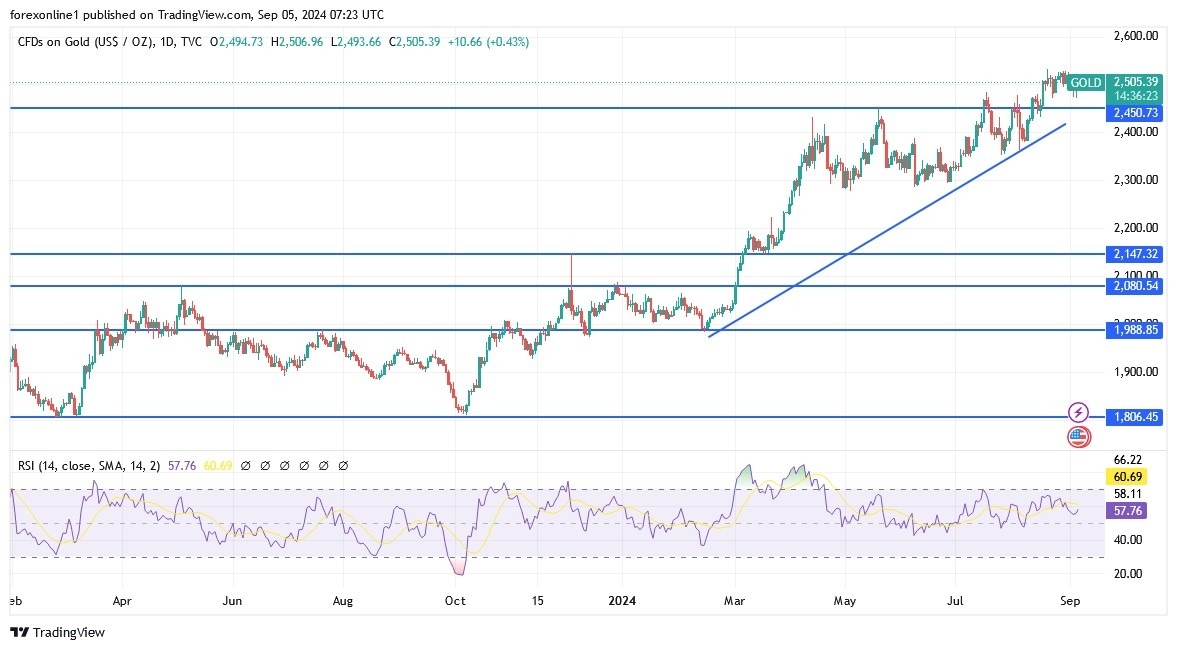- We have often emphasized that buying gold at every dip is the best trading strategy for gold.
- After recent profit-taking selling pushed gold to the $2472 per ounce support level, the gold price has rebounded again above the psychological resistance of $2500 per ounce, stabilizing around $2508 per ounce at the time of writing.
- The gold price may remain high until the financial markets and the US dollar react to the announcement of US jobs figures, which will have a strong and direct impact on the future of US interest rate decisions this month.

According to the platforms of gold trading companies, the price of gold stabilized higher after declining in previous sessions, as investors evaluated new economic data and its impact on US interest rate expectations from the Federal Reserve. Data from the Institute for Supply Management showed that manufacturing activity in the United States of America declined more than expected in August, highlighting the weakness of the sector and challenging the idea that the US economy is still resilient in the face of high borrowing costs.
Meanwhile, expectations of a dovish shift have been tempered by a sharper-than-expected rise in commodity producer prices. Investors are now awaiting additional economic data, including the key US jobs report later this week, which will provide insights into the Labor market’s performance since July’s weak report and a large downward revision to payrolls for the year ending March 2024. Financial markets are still pricing in a 100-basis point rate cut by the Federal Reserve during its remaining three meetings this year, which would lower the opportunity cost of holding non-interest-bearing assets.
As for the factors affecting the gold market. The US Dollar Index fell below 101.5. According to reliable trading platforms, the US Dollar Index DXY fell below 101.5 on Wednesday, paring its rebound from a 14-month low of 100 touched on August 19 amid expectations that the Federal Reserve will cut US interest rates significantly this year. The JOLTS report showed that US job openings unexpectedly fell to their lowest level in more than three years in July, dampening hopes for a hot jobs report on Friday. Moreover, in line with concerns about a weaker labour market that prompted a clear dovish turn by Fed Chair Powell in his Jackson Hole speech.
Furthermore, this added to the sharper-than-expected decline in domestic manufacturing activity highlighted by the ISM Purchasing Managers’ Index, which also prompted investors to pay attention to the resilience of the US in the face of higher interest rates. As a result, investors increased their positions reflecting 125 basis points of rate cuts in the remaining three Fed decisions this year, compared to the consensus of 100 basis points of cuts last week.
Meanwhile, the Bank of Canada’s rate cut weakened the Canadian dollar and prevented a sharp decline in the US dollar index.
Another factor affecting the market: The US 10-year Treasury yield hits a four-week low. The yield on the benchmark 10-year Treasury note fell below the 3.8% threshold on Wednesday, its lowest level in more than 14 months, helped by increased demand for safer assets as a slew of weak economic data boosted expectations of multiple rate cuts by the Federal Reserve this year. The JOLTS report showed that job openings unexpectedly fell to their lowest level in more than three years in July, prompting markets to believe that Friday’s jobs report could miss expectations for a second straight month.
Meanwhile, the yield on the 2-year note fell below the 10-year note yield for the first time since 2021.
On the stock trading front, U.S. stocks closed mixed on Wednesday, after posting their worst day since early August in the previous session. Also, the S&P 500 fell 0.1%, the Nasdaq lost 0.3% and the Dow Jones Industrial Average rose 37 points. Markets were pricing in a JOLTS report that showed a slight decline in July job openings, sending bond yields lower and raising bets that the Federal Reserve could deliver a big rate cut, with traders increasingly expecting a 50-basis point cut.
Energy stocks led the declines, with Exxon Mobil and Chevron down 1.2% and 1.7%, respectively. Technology stocks were also weaker, with Nvidia down 1.6% amid AI concerns. Intel shares lost 3.3% after Reuters reported that the company’s silicon chips failed tests conducted by Broadcom. Meanwhile, GitLab shares, surged 21.6% after it raised its fiscal 2025 sales forecast to between $742 million and $744 million, beating its previous estimate of $733 million to $737 million.
Top Forex Brokers
Gold Price Forecast and Analysis Today:
According to today's gold analysts' expectations, and according to the performance on the daily chart, the general trend of the gold price is still upward. Technically, the stability around and above the psychological resistance of $2,500 per ounce confirms the strength and control of the bulls over the trend. Although these gains are sufficient to push the technical indicators towards strong buying saturation levels, the gold price is receiving strong momentum from the increasing global geopolitical tensions and the trend of global central banks to ease their monetary policy.
Ready to trade our Gold price forecast? We’ve made a list of the best Gold trading platforms worth trading with.
